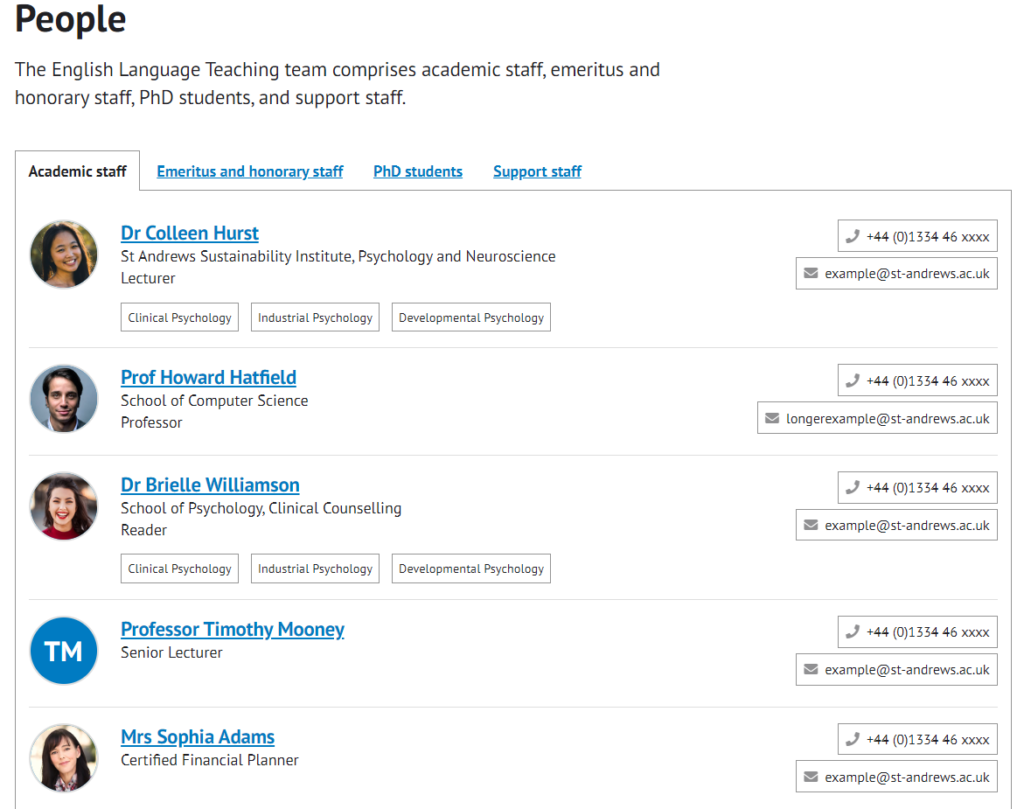Academic Schools project
The Academic Schools project has lasted nearly two years. With the launch of the School of Biology on 4 June 2020 it brought to completion the redesign of 24 different websites.
The project has been completed on time, which is a huge achievement for everyone involved – IT Services, digital communications team, BTPO, computer officers, the PURE team, HR, School staff and many more.
The new websites incorporate a number of features that will improve user experience and make the maintenance of the sites easier.
Consistent information architecture
The following is a list of all the sites that were redesigned:
- Art History
- Biology
- Chemistry
- Classics
- Computer Science
- Divinity
- Earth and Environmental Sciences
- Economics and Finance
- English
- Film Studies
- Geography and Sustainable Development
- Graduate School
- History
- International Relations
- Management
- Mathematics and Statistics
- Medicine
- Modern Languages
- Music
- Philosophy
- Physics and Astronomy
- Psychology and Neuroscience
- School of Philosophical, Anthropological and Film Studies
- Social Anthropology
Each site has the same core information architecture with the same URL structure:
- People (/people)
- About (/about)
- Prospective students (/prospective)
- Research (/research)
- Current staff (/staff)
- Current students (/students)
For a number of Schools they also had news and events. The information architecture was derived after analysing website traffic to the old School sites, usability testing and gathering requirements from the School. Each site had an external facing website presence intended for prospective students, while the internal content for staff and students was typically accessed via a password. A standard navigation structure makes it easier for students (prospective and current) to find information on different School sites.
Standardised visual design
Each School site used the digital pattern library to provide consistent visual design. Changing images enabled Schools to reflect the unique aspects of each discipline.
Using the digital pattern library will also enable Schools to meet accessibility requirements and makes any future design updates a lot easier.
Improved content management
With the exception of the internal content, all the sites are using T4v8 for the content management system. Prior to the Schools project, only half of the websites were in T4, the remainder were hosted on other systems such as WordPress. Having everything hosted in T4 means that there is now central oversight for the websites and it is easier to provide support where needed.
Training
For each School site a limited number of moderators were trained in writing for the web and T4. They had to attend the training sessions before being allowed access to the sites. In this way we could ensure that everyone had the appropriate training and support.
Handover pack
A handover pack was created for each School to give them an editorial calendar, the website policy and guidance, contact details, and any specific documentation that relates to a specific school feature.
Information from central sources
Another key part of the project was providing content from central sources. In this way information was not duplicated on the website and there was no risk of details being out of date. Central data was used for the following areas of the School websites.
People
We knew before the project started that staff profiles on School websites were the most popular pages. However, each School had a different approach to managing this information. Some Schools used information held with the research system called ‘Pure’, while others manually maintained the details. Now every School website uses data from central sources and in a standard format. This now ensures a consistent user experience and minimises the management needed to maintain this information.
PhD supervisors
Similarly, some Schools manually maintained a list of PhD supervisors. This information is now retrieved from central sources.
Events
School related events are now automatically brought in from the central University events calendar. Previously a lot of Schools had to manually enter events information into the central events calendar and the School website. If details of an event changed the content would have to be updated in two places.
Launch and beyond
Due to the diverse nature of each academic School the project has presented a lot of technical, design and content challenges in the process of moving from the old to the new website. However, now that we have solutions for each of these areas we ensure that the management of the websites are sustainable in the long term and continue to be a positive experience for all our users.



